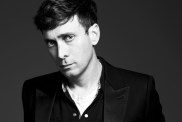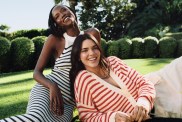After shattering old paradigms and creating new worlds with Blonde on Blonde, Dylan’s motorcycle mash-up in 1966 left him with lacerations on his face and scalp, several broken vertebrae, and a concussion. It was rumored that he was in critical condition for a short time, and that he suffered from mild amnesia. However, the extent of his injuries would eventually become a source of contention for Dylan biographers. As with much of Dylan’s life, there is a hint of the unknown. It rumored that a New York Post reporter who attempted to get the scoop shortly after the accident was chased off the property by watchdogs.
What is certain is that while Rock and Roll’s poet laureate may have spent the next nine months in seclusion, he didn’t stop writing. So where do you go after turning folk music on its head, revolutionizing rock, and redefining the role of the singer-songwriter, all the while maintaining an acute fashion sense?



Just as he traded in plaid shirts for polka dots when he went electric in the mid 1960’s, during the early 1970’s, his straightforward lyrics were accompanied by a change in dress: for all intents and purposes, Dylan went country cowboy for a time. He even made a forgettable appearance in Sam Peckinpah’s film, Pat Garrett and Billy the Kid. It could be argued that he might not have needed the wardrobe department to fit in on the set. However, one bright note: the timeless “Knockin’ on Heaven’s Door” was written for the soundtrack.

!975 marked the release of Blood on the Tracks, an album that many feel signaled a return to form. The album featured “Tangled up in Blue,” which is, arguably, Dylan at his most lyrically innovative. Clearly influenced by the underpinnings of Cubism, the track plays with the notion that all surfaces and angles of a subject can be depicted simultaneously. Here, Dylan tells a love story that confounds the notions of beginning, middle, and end – time itself is exploded and re-imagined.
Dylan was on a roll again. Case in point, The Rolling Thunder Revue. The tour was hailed as a huge success and featured a supporting cast of characters that included Joan Baez, with whom Dylan had not shared a stage in many years. In addition, Joni Mitchell played a part, a relatively unknown Sam Shepard was brought on to write a screenplay for a film that would document the tour, Allen Ginsberg was slated to do spoken word poetry, and Mick Ronson, lead guitarist from David Bowie’s backing band, The Spider’s From Mars, was also thrown into the mix.
Meanwhile, Dylan played the role not only of lead musician, but of wild gypsy or snake oil salesman from the old West. It was a musical extravaganza, a traveling carnival. Photographs show Dylan in face paint and carnival barker-like get-ups with feathered hats and masks. He truly embraced the theory that donning a costume can be transformative. And while the idea itself is centuries old, thereby situating Dylan within certain literary and cultural traditions, it is interesting because we are able to see that perhaps these transformations are a necessary tool for someone who lives life on the stage. Regardless, Dylan’s minstrel inspired whiteface paint coupled with his cowboy hat with a red flower on the brim is an iconic look.
His next album, Desire (1976), was completed after the first half of the tour ended in 1975. It included gems like “Sara,” a heartbreaking ode to his estranged wife, Sara Lowndes. And, for the first time since the early days, Dylan penned a protest song, “Hurricane,” which championed the cause of the wrongfully imprisoned boxer Ruben “Hurricane” Carter. Quite frankly, the song is beautiful, organic, and Dylan’s lyrics are a harsh condemnation of the terrible nature of racial injustice in America. Indeed, this is Dylan at his best. Or rather, this is a version of Dylan at his best. The point is that Dylan had so many masks it is often difficult to say who he really is. But it is easy to recognize the genius – even when he’s wearing a fur-trimmed western coat with cowboy hat and scarf.
Check out Bob Dylan, Style Icon Part 1 here.





